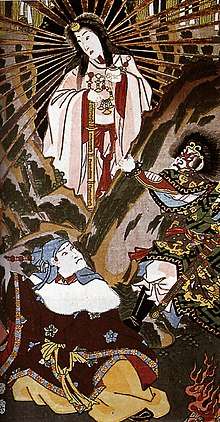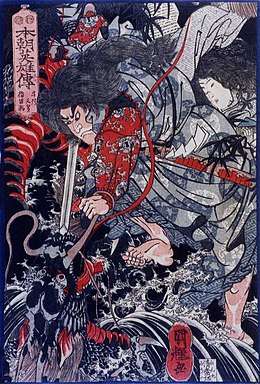Kushinadahime
In the Shinto religion, Kushinadahime or Kushi-nada-hime (Japanese: クシナダヒメ; Kojiki: 櫛名田比売, Nihonshoki: 奇稲田姫, Kushiinadahime, "wondrous Inada princess"[1]) is a goddess (kami) of rice.[1] She is the wife of the god Susanoo, who rescued her from the monster Yamata-no-Orochi and made her a deity.
She is the older sister of the goddess Kamu'ō-ichi-hime (神大市比売) and a daughter of Ōyamatsumi (大山津見神), the half-brother of Susanoo. She is also known as Ina-Gami Furu-Kushi-Nada-Hime ("True-hair-touching princess") or Inagami-Hime.[1]
Myth
According to the Nihon Shoki, Susanoo saved Kushinadahime from the legendary serpent Orochi, as related in the following translation by William George Aston in Nihongi:
- "Then Sosa no wo no Mikoto descended from Heaven and proceeded to the head-waters of the River Hi, in the province of Idzumo. At this time he heard a sound of weeping at the head-waters of the river, and he went in search of the sound. He found there an old man and an old woman. Between them was set a young girl, whom they were caressing and lamenting over.
- Sosa no wo no Mikoto asked them, saying: "Who are ye, and why do ye lament thus?" The answer was: "I am an Earthly Deity, and my name is Ashi-nadzuchi. My wife's name is Te-nadzuchi. This girl is our daughter, and her name is Kushi-nada-hime. The reason of our weeping is that formerly we had eight children, daughters. But they have been devoured year after year by an eight-forked serpent and now the time approaches for this girl to be devoured. There is no means of escape for her, and therefore do we grieve.” Sosa no wo no Mikoto said: "If that is so, wilt thou give me thy daughter?" He replied, and said: "I will comply with thy behest and give her to thee." Therefore Sosa no wo no Mikoto on the spot changed Kushi-nada-hime into a many-toothed close-comb which he stuck in the august knot of his hair. Then he made Ashi-nadzuchi and Te-nadzuchi to brew eight-fold sake, to make eight cupboards, in each of them to set a tub filled with sake, and so to await its coming.
- When the time came, the serpent actually appeared. It had an eight-forked head and an eight-forked tail; its eyes were red, like the winter-cherry; and on its back firs and cypresses were growing. As it crawled it extended over a space of eight hills and eight valleys. Now when it came and found the sake, each head drank up one tub, and it became drunken and fell asleep.
- Then Sosa no wo no Mikoto drew the ten-span sword which he wore, and chopped the serpent into small pieces. When he came to the tail, the edge of his sword was slightly notched, and he therefore split open the tail and examined it. In the inside there was a sword. This is the sword which is called Kusa-nagi no tsurugi."[2]
Then Susanoo built a palace or shrine for Kushinadahime in Suga, and made her father Ashinazuchi its head (obito). On that occasion, according to the Kojiki, he composed a song in tanka form later held to be the root of Japanese waka poetry:[3]
Japanese Rōmaji Translated by William George Aston[4] 八雲立つ
出雲八重垣
妻籠みに
八重垣作る
その八重垣をYakumo tatsu
Izumo yaegaki
tsuma-gomi ni
yaegaki tsukuru
sono yaegaki oMany clouds arise:
The clouds which come forth (are) a manifold fence:
For the husband and wife to retire within
They have formed a manifold fence:
Oh! that manifold fence!
The Kojiki dedicates a chapter to the six generations of progeny of Susanoo and Kushinadahime, which include Isukeyorihime, the wife of Jimmu, the mythical first emperor of Japan.
Veneration and legacy
Kushinadahime is principally venerated at the Hikawa Shrine in Saitama, which is dedicated to Susanoo, under the name of Ō-kushi-inada-hime-no-mikoto. A matsuri is held in her honor annually on 15 April.
She is also venerated at other shrines together with her husband, including at the Yasaka Shrine in Kyoto. At the annual Gion Matsuri, one of Kyoto's principal festivals, she is paraded through the city in a mikoshi together with Susanoo.
The asteroid 10613 Kushinadahime, discovered in 1997, is named after Kushinadahime.
References
- Coulter, Charles Russell (2013). "Kushi-nada-hime". Encyclopedia of Ancient Deities. Hoboken: Taylor and Francis. p. 282. ISBN 9781135963903.
- W. G. Aston, C.M.G. (1896). "Book I: The Age of the Gods". Supplement: Nihongi, chronicles of Japan from the earliest times to A.D. 697. Vol. I. London: Kegan Paul, Trench, Trübner & Co., Limited. pp. 52–53. Retrieved 27 December 2012.
- Mori Mizue: "Kushinadahime". Encyclopedia of Shinto, Kokugakuin University, retrieved on 1 January 2014
- http://www.sacred-texts.com/shi/kj/kj026.htm#fn_447

